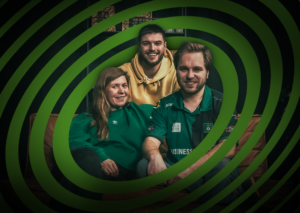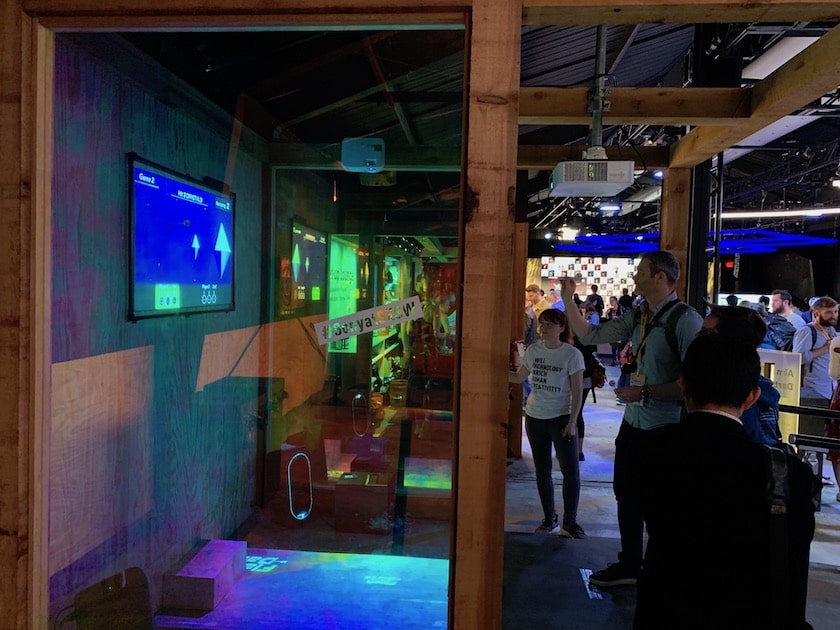
Do you want to innovate your marketing?
Check out which types of innovations exist and how to get started

The 2019 South By Southwest (SXSW) festival is over, and I’m having the Southby blues.
I left feeling inspired, enthused and also exhausted from 10 days of amazing sessions, being at the center of (sport) innovation, good networking and having fun with cool and likeminded people.
This whole event felt like being back in university where learning, fun and meeting people was the center of my universe.
Now that it’s finished I feel like a small fish in the pond having been surrounded by global +1000 employee agencies, the NFL and brands like Lululemon.
With all this innovation happening in the sport industry and all new technology available, I have the feeling there’s so much more innovation that needs to happen and we have to move fast!
Talking to peers though I realized there’s a big gap between the future and the realistic now.
You have to be aware of the future in order to prepare for it in the now.
Next to product or service innovation which needs to happen continuously, it doesn’t make sense to implement AI or VR when you still have big progress to make by fixing the basics.
Just like I advise sportstech start-ups to focus on customer service and sales before focusing on PR and marketing, as you’ll get results much faster in that order.
So that’s why I decided to make this wrap-up a very realistic, down-to-earth article: The 10 ready-to-implement learnings from South By South west.
Gen Y is different. You’ll hear this phrase at basically any marketing event. Because it’s true.
Their desired content is authentic, it’s engaging, it’s entertaining. International as well, as the internet broke all borders for them.
They don’t want to see hidden commercial messages, they want to learn about athletes, lifestyles and get a true look behind the scenes of your club or brand.
It’s no longer enough to post content about competitions and the results. Research by Bleacher Report showed that “40% of the most engaged sports content were off-court moments“.
So each time you post something, do the “who cares” test and ask yourself whether anyone outside your own organization cares about what you’re about to post.
Also be inspired by some best practices by following these channels:
Let me know if you’d like dive deeper into the numbers and receive the full research by Bleacher report!
So whether we like it or not – or even whether you deem esports to be an actual sport which is a different conversation – esports is coming.
Hell no – it’s already here.
And it is innovating the whole sports industry. I
n the past, esports presenters used to take classes to learn how to act as sports presenters, while the exact opposite is happing right now.
Why? In esports, players and broadcasters are managing to engage very closely with their fans. And their streaming technology is way ahead of traditional sports.
Imagine a basketbal player streaming their warm-up while interacting live with his fans?
Or fans being able to create a short shareable clip directly captured from a live event.
These are things we cannot imagine yet.
Esports reaches a level of engagement we couldn’t even dream of in traditional sports so there’s a huge potential for traditional sports to take learnings from esports.
How? Just start by réally getting to know the industry:
Follow some esports legends like: “Ninja” ** Faker ** Sneaky .
Be ready to be surprised! Oh and download the Twitch app while you’re at it.
Due to the growing requirements of fans in terms of engagement, it’s time to rethink your sponsorship.
What’s worth more to your brand: top performing athletes with basic to no social media presence or low to mid scale athletes who have a huge fan base?
The answer is: you need both.
Top performing athletes can provide status for your brand, sending the message that if they use it, it must be top-notch quality.
While athletes who are engaging and focus on more manageable goals are more accessible and can help you to create a community.
Also consider the athletes who can be placed in the middle.
Think about Stefaan Engels, known as “Marathonman” – who ran a marathon a day for a year.
This is an extreme performance, but measuring each marathon individually, he definitely wouldn’t be one of the top performers so wouldn’t be considered a top athlete.
When I worked at Etixx, we already made a sponsorship strategy with a division in budget between top athletes and athletes with a possibly lower level but higher engagement.
Also, remember to consider esports.
If you’re a soccer team, wouldn’t it make sense to sponsor a top FIFA player as well to get access to a whole new target audience?
Again, think about a top performing one vs one with a huge social media following. And make sure they fit your brand!
Athletes: here’s where personal branding comes in!
AI has so many different possible benefits that I don’t know where to begin. Everyone is getting on board with this technology but remains still quite intangible.
Here are some of the many use cases:
For athletes, teams and braodcasters, you have companies like Sportlogiq, who offer AI to automate your content creation process, by automatically creating clips of the most exciting moments of a game in order to reach better engagement on social.
To have more fan engagement, England’s Wimbledon launched an interactive app called “Ask Fred” which allows fans to get answers on event logistics and history.
Trainers, athletes and teams can benefit from AI to help improve the decision making process, by tracking performance data and giving real-life recommendations or identify imperfections in techniques.
For brands, there are many implementations.
You have an AI personal personal assistant who helps you to plan meetings.
Though the most implemented type is customer service automation.
According to an article about the future of AI in customer service by CIO, 80 per cent of customer service interaction is expected to be handled by AI in 2020.
But how do you get started?
I would advise to start with AI that helps to streamline internal processes, I was told that Hook-IT uses
AI technology to measure the reach of your sponsorship content.
Sportlogiq helps identify future talent in a specific sport.
Once you get used to working with these tools & technology for ‘internal purposes’, you can take the next steps in implementing AI that immediately impacts your customer.
Because when you do it, you want to do it right.
There’s nothing more frustrating than AI-driven customer service which isn’t able to deliver a qualitative and quick answer to the customer.
VR has many potential benefits for the sports industry.
Creating a VR version of a traditional sport can help athletes to practise their tactics & techniques at home which enables more training hours.
Check out the VR game Elvenassasin, where you shoot bow & arrow to protect your castle against Orks. The game is designed – or at least so it seems – so that won’t hit them if you’re not using the right technique.
But the benefits also work reversed. The most popular game beatsaber is very accessible to non-sportive people. Similar to how the Wii used to help sedentairy people become a bit more active.
The world of VR is also innovating and becoming rapidly more accessible.
You used to need very big and expensive equipment to play it, but at SXSW, for the first time I tried VR technology (by SAP in cooperation with Qualtrics) which doesn’t require any handles or glasses anymore, just a responsive plate.
So image this..
I walk into my sports club about an hour before my practice starts.
After I changed, I walk into the VR room to work on my technique and warm-up for about 15-30 minutes.
When my actual training, my coach will received a short summary of this data with some take-aways of which techniques have progressed from the previous work and which could use more advancement.
I already had my warm-up and a short stretch, so we can start on the real work immediately and I have less chance on getting injured.
After my training, I can choose whether to continue on my stamina and maintain the real-life training without my trainer or to continue some more VR training, to work on my reflexes or repeat some of the new techniques I’ve learned.
Think of how this could change the way we train? Or in other situations where this low-entry experience of a sport can be beneficial?
Imagine this is implemented in primary school to support kids to choose a sports they like?
How to start?
It’s time to experience the technology yourself.
In Belgium for example, we have the VR sports cube which specifically focuses on sports – powered by R.A.V.E.N and initiated by sport.vlaanderen.
But you have VR arcades all over the world, just look them up in your region.
Even a non-sports VR game and some imagination will be sufficient to give you an idea of the technology and how it could be implemented in sports.

As a tech-geek, I find augemented reality the coolest thing ever.
In events, stores or any offline activation, the trick is always to stay fun, relevant, and capture people’s attention.
Augmented reality is just the way to go here.
Ok I admit, not the easiest to implement due to the required budget, but this just needed to be part of this list.
Check out this example:
So now that sports betting has become legal in the US, a LOT of innovation is going on. It is not only impacting the available budgets of teams and players, but also their use of technology.
Most betting happens after the game has already started, which created the urge to have Wifi in stadiums and the technology to place microbets easily and quickly.
The technology will also have to allow for personalised ads, based on the fan bahaviour and location in the venue, so that you can show.
Also in terms of performance data – where by the way lie huge opportunities for wearable brands – as users want to bet on more than the outcome of a game alone, they are betting on which player will make the most goals in soccer, have the highest heart rate, or will run the most laps..
Even if betting has been legal in Europe for a while now, these innovations are happening here as well.
Being able to stream and share clips of events, having wifi in stadium to share experiences directly, getting more insight in player’s data.
This is a universal trend of which sports betting in the US is one the incubators, but certainly not the only one.
Get inspired
The Mercedes-Benz Stadium – Atlanta, Georgia – was elected the most innovative ànd sustainable stadium in the world. Start by learning which innovations are already happening globally:
Is on the rise and can just make your life easier.
That’s all I wanted to point out here.
So my advice: do you hate doing a specific action? Google it!
I’m sure that somewhere on this planet, a solution has already been created for this problem.
Looking for the perfect b-ball training buddy anyone?
I already mentioned the storytelling, esports which could open up a new target audience, the change in sponsorship and new ways to interact with your audience.
Just remember that one thing will always stay the same: your customer should remain the centre of your universe. So remember who he is – and who you are.
Here are some more take-aways specifically on marketing strategy:
Authentic brand story
Telling a good and authentic brand story – or defining your personal branding for individuals, is crucial.
In one of the music session I learned about how broadcasters need to define their goal, and received the advice not to care too much about your audience, just be yourself, get your message out there and likeminded followers will join automatically.
Plus, create good content because average content just won’t do it anymore. One of the best examples that was raised multiple times (and which I’m a huge fan of personally) is Lululemon.
Just take a look at their business and marketing, their story is just so obvious.
So take the time and think: do you have a clear brand story worth sharing with the world?
And do you get it out there? In my situation – I know I need to work on that myself.
Co-creation
And we have the opportunity that especially the younger generating wants to interact more than ever.
So use this opportunity and interact with your fans. Take a look at the impressive example of the Overwatch league: they co-create éverything together with their fans: The logo, the players, the trainer and even how the game end or which rules should be adjusted!
I found this incredibly innovative.
Implement this by starting to engage your customers in small decisions.
When I worked at Etixx, we asked our followers which design of cycling outfit they preferred.
People who voted for the design that was chosen were obviously the first to buy it afterwards, as they felt part of the process.
Test new channels
Especially the younger generation is very international, they don’t care which part of the world their content is coming from, as long as it’s entertaining.
One of the biggest mutual strategies of the major sports leagues in the US (NFL, NBA, NHL), is to try and create fans internationally.
But in order to do that, you need to know where to reach them.
So do some research on which channels are popular in other markets. Here’s some I discovered during SXSW:
Next to the inspiring sessions I’ve followed, I also learned so much just talking to other industry professionals from over the world.
Getting their views and seeing the evolutions in their countries is just so valuable.
Wether it are new ideas or similar softwares that are being developed, it’s important to know about it!
So my advice: get in touch with as many sports professionals as possible and share your learnings so we can grow this business together.
So do connect with me on LinkedIn, Instagram or email and share which events you’re planning to attend the coming months!
That’s a wrap!
Please let me know what you think!
I’m sure I’ve forgotten màny of the other trends that were mentioned so don’t hesitate to complement with your own opinions!
These are the ones that lingered most for me.
Thank you SXSW for including a sports track, I’ll be back next year for sure!
We don’t have time to spam you 🙂 We’ll just send useful tips & trics, case studies from previous projects & free templates, promise!



Check out which types of innovations exist and how to get started
